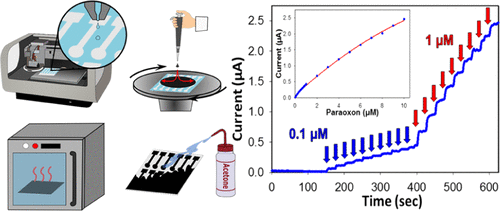当前位置:
X-MOL 学术
›
ACS Appl. Mater. Interfaces
›
论文详情
Our official English website, www.x-mol.net, welcomes your
feedback! (Note: you will need to create a separate account there.)
Printed Graphene Electrochemical Biosensors Fabricated by Inkjet Maskless Lithography for Rapid and Sensitive Detection of Organophosphates
ACS Applied Materials & Interfaces ( IF 8.3 ) Pub Date : 2018-03-05 00:00:00 , DOI: 10.1021/acsami.7b19763 John A. Hondred 1 , Joyce C. Breger 2 , Nathan J. Alves 2 , Scott A. Trammell 2 , Scott A. Walper 2 , Igor L. Medintz 2 , Jonathan C. Claussen 1, 3
ACS Applied Materials & Interfaces ( IF 8.3 ) Pub Date : 2018-03-05 00:00:00 , DOI: 10.1021/acsami.7b19763 John A. Hondred 1 , Joyce C. Breger 2 , Nathan J. Alves 2 , Scott A. Trammell 2 , Scott A. Walper 2 , Igor L. Medintz 2 , Jonathan C. Claussen 1, 3
Affiliation

|
Solution phase printing of graphene-based electrodes has recently become an attractive low-cost, scalable manufacturing technique to create in-field electrochemical biosensors. Here, we report a graphene-based electrode developed via inkjet maskless lithography (IML) for the direct and rapid monitoring of triple-O linked phosphonate organophosphates (OPs); these constitute the active compounds found in chemical warfare agents and pesticides that exhibit acute toxicity as well as long-term pollution to soils and waterways. The IML-printed graphene electrode is nano/microstructured with a 1000 mW benchtop laser engraver and electrochemically deposited platinum nanoparticles (dia. ∼25 nm) to improve its electrical conductivity (sheet resistance decreased from ∼10 000 to 100 Ω/sq), surface area, and electroactive nature for subsequent enzyme functionalization and biosensing. The enzyme phosphotriesterase (PTE) was conjugated to the electrode surface via glutaraldehyde cross-linking. The resulting biosensor was able to rapidly measure (5 s response time) the insecticide paraoxon (a model OP) with a low detection limit (3 nM), and high sensitivity (370 nA/μM) with negligible interference from similar nerve agents. Moreover, the biosensor exhibited high reusability (average of 0.3% decrease in sensitivity per sensing event), stability (90% anodic current signal retention over 1000 s), longevity (70% retained sensitivity after 8 weeks), and the ability to selectively sense OP in actual soil and water samples. Hence, this work presents a scalable printed graphene manufacturing technique that can be used to create OP biosensors that are suitable for in-field applications as well as, more generally, for low-cost biosensor test strips that could be incorporated into wearable or disposable sensing paradigms.
中文翻译:

喷墨无掩模光刻技术制备的石墨烯电化学生物传感器,用于快速,灵敏地检测有机磷酸酯
石墨烯基电极的固溶相印刷近来已成为一种有吸引力的低成本,可扩展的制造技术,可用于创建现场电化学生物传感器。在这里,我们报告通过喷墨无掩模光刻(IML)开发的一种基于石墨烯的电极,用于直接和快速监测三O连接的膦酸酯有机磷酸盐(OPs);它们构成化学战剂和农药中发现的活性化合物,具有急性毒性以及对土壤和水道的长期污染。IML印刷的石墨烯电极采用1000 mW台式激光雕刻机进行纳米/微结构处理,并电化学沉积铂纳米颗粒(直径约25 nm),以提高其导电性(薄层电阻从约10000降低至100Ω/ sq),表面区域,以及随后用于酶功能化和生物传感的电活性性质。磷酸三酯酶(PTE)通过戊二醛交联结合到电极表面。所得的生物传感器能够以较低的检测限(3 nM)和高灵敏度(370 nA /μM)快速测量(5 s响应时间)杀虫剂对氧磷(模型OP),而来自类似神经系统的干扰却可以忽略不计。此外,该生物传感器具有较高的可重用性(每个传感事件的灵敏度平均降低0.3%),稳定性(在1000 s内保持90%的阳极电流信号),寿命(在8周后保持70%的灵敏度)以及选择性传感的能力实际土壤和水样中的OP。因此,
更新日期:2018-03-05
中文翻译:

喷墨无掩模光刻技术制备的石墨烯电化学生物传感器,用于快速,灵敏地检测有机磷酸酯
石墨烯基电极的固溶相印刷近来已成为一种有吸引力的低成本,可扩展的制造技术,可用于创建现场电化学生物传感器。在这里,我们报告通过喷墨无掩模光刻(IML)开发的一种基于石墨烯的电极,用于直接和快速监测三O连接的膦酸酯有机磷酸盐(OPs);它们构成化学战剂和农药中发现的活性化合物,具有急性毒性以及对土壤和水道的长期污染。IML印刷的石墨烯电极采用1000 mW台式激光雕刻机进行纳米/微结构处理,并电化学沉积铂纳米颗粒(直径约25 nm),以提高其导电性(薄层电阻从约10000降低至100Ω/ sq),表面区域,以及随后用于酶功能化和生物传感的电活性性质。磷酸三酯酶(PTE)通过戊二醛交联结合到电极表面。所得的生物传感器能够以较低的检测限(3 nM)和高灵敏度(370 nA /μM)快速测量(5 s响应时间)杀虫剂对氧磷(模型OP),而来自类似神经系统的干扰却可以忽略不计。此外,该生物传感器具有较高的可重用性(每个传感事件的灵敏度平均降低0.3%),稳定性(在1000 s内保持90%的阳极电流信号),寿命(在8周后保持70%的灵敏度)以及选择性传感的能力实际土壤和水样中的OP。因此,











































 京公网安备 11010802027423号
京公网安备 11010802027423号